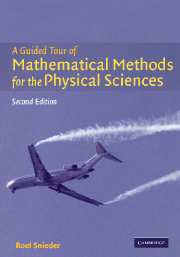Book contents
- Frontmatter
- Contents
- Preface to Second Edition
- Acknowledgements
- 1 Introduction
- 2 Dimensional analysis
- 3 Power series
- 4 Spherical and cylindrical coordinates
- 5 Gradient
- 6 Divergence of a vector field
- 7 Curl of a vector field
- 8 Theorem of Gauss
- 9 Theorem of Stokes
- 10 Laplacian
- 11 Conservation laws
- 12 Scale analysis
- 13 Linear algebra
- 14 Dirac delta function
- 15 Fourier analysis
- 16 Analytic functions
- 17 Complex integration
- 18 Green's functions: principles
- 19 Green's functions: examples
- 20 Normal modes
- 21 Potential theory
- 22 Cartesian tensors
- 23 Perturbation theory
- 24 Asymptotic evaluation of integrals
- 25 Variational calculus
- 26 Epilogue, on power and knowledge
- References
- Index
21 - Potential theory
Published online by Cambridge University Press: 05 June 2012
- Frontmatter
- Contents
- Preface to Second Edition
- Acknowledgements
- 1 Introduction
- 2 Dimensional analysis
- 3 Power series
- 4 Spherical and cylindrical coordinates
- 5 Gradient
- 6 Divergence of a vector field
- 7 Curl of a vector field
- 8 Theorem of Gauss
- 9 Theorem of Stokes
- 10 Laplacian
- 11 Conservation laws
- 12 Scale analysis
- 13 Linear algebra
- 14 Dirac delta function
- 15 Fourier analysis
- 16 Analytic functions
- 17 Complex integration
- 18 Green's functions: principles
- 19 Green's functions: examples
- 20 Normal modes
- 21 Potential theory
- 22 Cartesian tensors
- 23 Perturbation theory
- 24 Asymptotic evaluation of integrals
- 25 Variational calculus
- 26 Epilogue, on power and knowledge
- References
- Index
Summary
Potential fields play an important role in physics and geophysics because they describe the behavior of gravitational and electric fields as well as a number of other fields. Conversely, measurements of potential fields provide important information about the internal structure of bodies. For example, measurements of the electric potential at the Earth's surface when a current is sent into the Earth give information about the electrical conductivity while measurements of the Earth's gravity field or geoid provide information about the mass distribution within the Earth.
An example of this can be seen in Figure 21.1 in which the gravity anomaly over the northern part of the Yucatan peninsula in Mexico is shown [49]. The coast is visible as a thin white line. Note the ring structure that is visible in the gravity signal. These rings have led to the discovery of the Chicxulub crater which was caused by the massive impact of a meteorite. Note that the diameter of the impact crater is about 150 km! This crater is presently hidden by thick layers of sediments: at the surface the only apparent imprint of this crater is the presence of underground water-filled caves called “cenotes” at the outer edge of the crater. It was the measurement of the gravity field that made it possible to find this massive impact crater.
The equation that the gravitational or electric potential satisfies depends critically on the Laplacian of the potential.
- Type
- Chapter
- Information
- A Guided Tour of Mathematical MethodsFor the Physical Sciences, pp. 353 - 378Publisher: Cambridge University PressPrint publication year: 2004



